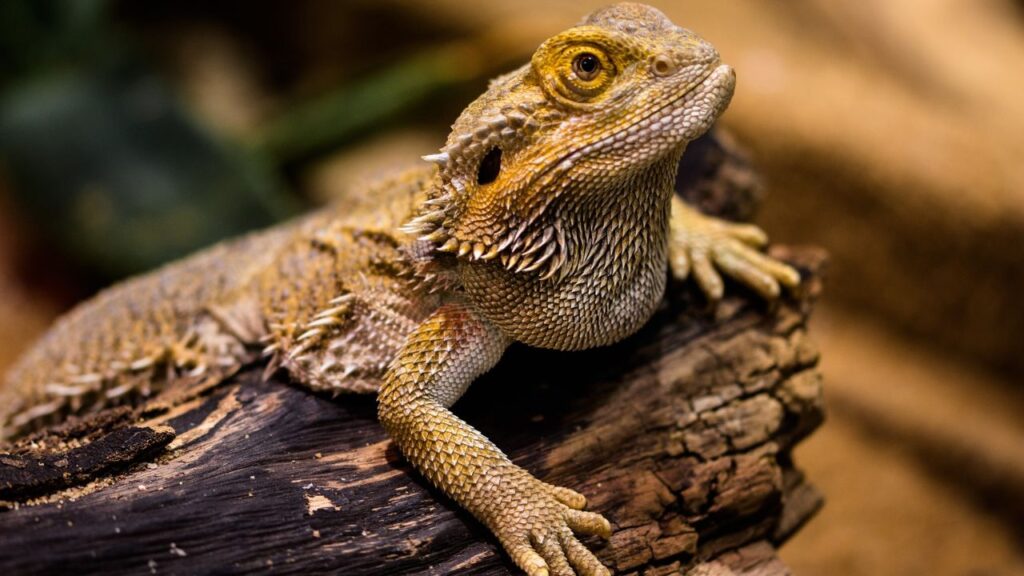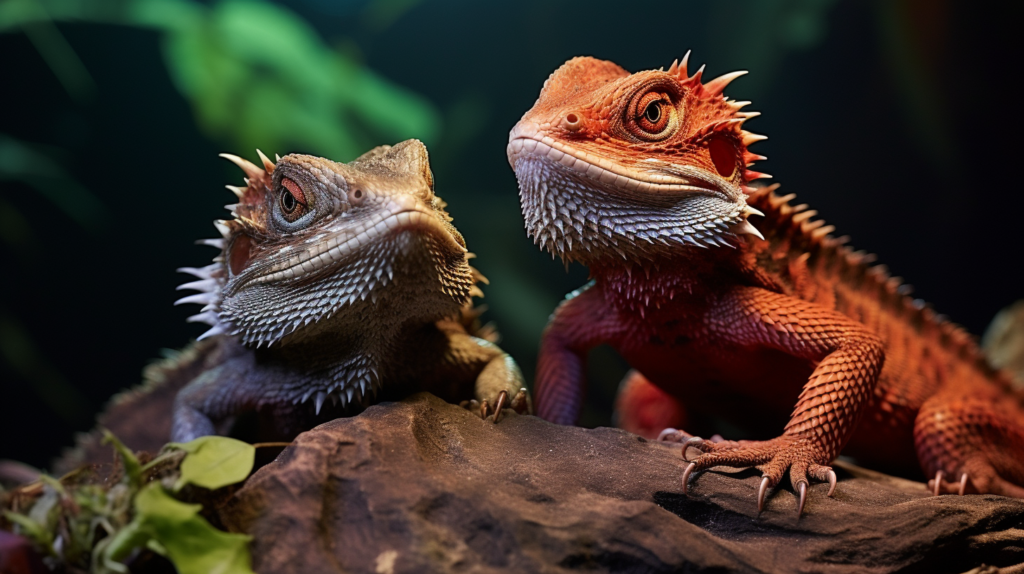Is your bearded dragon sporting swollen limbs? This could point to a variety of health issues that need your attention.
Swelling often arises from injuries, infections, or nutritional deficiencies, each requiring a specific response. Don't dismiss these signs as minor; they could indicate more serious underlying problems.
As you assess your pet's condition, reflect on their environment and care practices. The actions you take next are crucial for your bearded dragon's well-being.
Common Injuries and Trauma
Common injuries and trauma, like fractures or sprains, can cause your bearded dragon's limbs to swell considerably. If you notice swelling, it's important to assess your pet for any signs of injury. Check for any visible wounds, broken bones, or unusual behavior. Your bearded dragon might be reluctant to move or may show signs of discomfort when you touch the affected limb.
If you suspect an injury, it's imperative to provide a safe environment for your dragon. Remove any obstacles or sharp objects from its habitat that could exacerbate the injury. You should also consider limiting its activity until you can seek veterinary care. The vet may recommend X-rays to determine the extent of the injury, especially if a fracture is suspected.
In some cases, swelling may not show immediately after an injury occurs, so always monitor your dragon closely. Ice packs wrapped in cloth may help reduce swelling temporarily, but consult your vet for the best treatment options. Remember, timely intervention is crucial. Addressing injuries quickly can prevent further complications and help your bearded dragon recover more effectively.
Infections and Diseases
Infections and diseases can lead to swollen limbs in your bearded dragon, and recognizing the signs early is essential.
You should look for common symptoms like lethargy, swelling, and discoloration, which may indicate underlying health issues.
Understanding these infections will help you take the right steps to guarantee your pet gets the proper care it needs.
Common Infections Overview
Many bearded dragons can develop swollen limbs due to various infections that affect their health and well-being. Common infections include bacterial, fungal, and parasitic infections, each posing unique risks to your pet.
Bacterial infections can arise from wounds or poor living conditions, leading to inflammation and swelling. Fungal infections often develop in humid environments, where mold or spores thrive, causing skin irritation and swelling in the limbs.
Parasitic infections, such as those caused by mites or worms, can also lead to swelling as your dragon's body reacts to the invaders. These infections may not only affect the limbs but can also lead to systemic issues if left untreated.
It's essential to maintain a clean habitat and monitor your bearded dragon for any signs of infection. Regular veterinary check-ups are vital for early detection and treatment of these infections.
Disease Symptoms Identification
Recognizing the symptoms of infections and diseases in your bearded dragon can help you address health issues before they escalate. One of the first signs of illness is a change in behavior. If your pet becomes lethargic, loses appetite, or isolates itself, these may indicate underlying health problems.
Swollen limbs can also signify infection, which might accompany redness or heat in the affected area. You should look for any unusual discharge from the eyes or mouth, as well as signs of respiratory distress like wheezing or labored breathing.
Pay attention to your dragon's stool. Diarrhea or abnormal droppings can signal gastrointestinal issues. If you notice any swelling or deformities in the limbs, it's essential to act quickly.
Changes in skin color, such as darkening or shedding irregularly, can also be warning signs. Regularly monitor your bearded dragon's overall health and environment to catch issues early.
If you observe any of these symptoms, consult a veterinarian experienced with reptiles. Prompt action can prevent more severe health complications down the line, keeping your bearded dragon healthy and happy.
Nutritional Deficiencies
Nutritional deficiencies can lead to swollen limbs in bearded dragons, often caused by an imbalanced diet lacking essential vitamins and minerals. These reptiles require a well-rounded diet that includes leafy greens, insects, and occasional fruits to thrive. If your bearded dragon isn't getting enough calcium, vitamin D3, or other vital nutrients, you might notice swelling in their limbs.
Calcium is particularly important, as it helps maintain bone health and proper muscle function. Without enough calcium, your bearded dragon could suffer from metabolic bone disease, which manifests as swelling and weakness. Vitamin D3 is essential for calcium absorption, so if their diet lacks this vitamin, it can worsen the issue.
To prevent nutritional deficiencies, you should provide a varied diet. Consider dusting insects with calcium and vitamin supplements to boost their intake. Offering a mix of greens, such as collard greens and kale, is also beneficial.
Regularly changing their diet can help guarantee they're getting all the nutrients they need. If you suspect your bearded dragon has swollen limbs due to nutritional deficiencies, consulting a veterinarian can provide you with tailored advice and treatment options.
Inadequate Hydration
Inadequate hydration can lead to swollen limbs in bearded dragons, as their bodies rely on sufficient water intake to maintain proper circulation and reduce swelling. When your dragon doesn't get enough water, it can result in dehydration. Dehydration can cause their blood volume to drop, making it harder for their bodies to function properly. As a result, you might notice swelling in their limbs.
To prevent this, you should provide fresh, clean water daily. Make sure your dragon has access to a shallow dish for drinking. Additionally, misting their environment with water can help increase humidity and encourage them to drink. Some bearded dragons also benefit from soaking in warm water for about 15 to 20 minutes a few times a week. This not only provides hydration but also helps with shedding.
Keep an eye on their behavior. If your dragon seems lethargic or shows signs of swelling, it's essential to assess their hydration levels. Remember, consistent hydration is important for your bearded dragon's overall health and well-being.
Parasites and Infestations
When you notice swollen limbs in your bearded dragon, parasites and infestations might be the culprit.
Common parasites can lead to various symptoms, and recognizing these signs early is essential for your pet's health.
Understanding treatment options and prevention strategies can help keep your dragon happy and healthy.
Common Parasites Identified
Common parasites like pinworms and mites can lead to swollen limbs in bearded dragons, signaling the need for prompt treatment.
Pinworms are internal parasites that often infest the gastrointestinal tract, causing stress and discomfort. You mightn't notice any visible symptoms right away, but over time, their presence can weaken your dragon's immune system and lead to swelling.
Mites, on the other hand, are external parasites that attach themselves to your bearded dragon's skin. These tiny pests can cause irritation and inflammation, which may manifest as swollen limbs. If you see your dragon scratching or rubbing against surfaces, it could be a sign of a mite infestation.
Other common parasites include coccidia and nematodes, which can also contribute to swelling and health issues.
Regular vet check-ups and fecal tests can help in identifying these parasites early on. If you suspect any parasitic infection, it's vital to consult a veterinarian immediately. Early diagnosis and treatment can prevent further complications and help your bearded dragon recover quickly.
Taking proactive measures will guarantee your pet stays healthy and happy.
Symptoms of Infestations
Swollen limbs in bearded dragons often signal an underlying infestation, and recognizing the symptoms early can make a significant difference in treatment. You might notice your dragon becoming lethargic, showing less interest in food, or even exhibiting weight loss. These signs can indicate that your pet is struggling with internal or external parasites.
Look for unusual behaviors, like scratching or rubbing against surfaces. This can suggest external parasites like mites or ticks. You may also see changes in their skin, such as lesions or discoloration. If your bearded dragon is hiding more than usual, it could be trying to cope with discomfort caused by these infestations.
In addition to physical symptoms, pay attention to their stool. Diarrhea or the presence of worms in droppings can point to intestinal parasites. If you notice any of these symptoms, it's essential to act quickly.
Early detection can help prevent more severe health issues for your pet. Monitoring your bearded dragon's behavior and physical condition regularly can aid in identifying these symptoms, ensuring they receive appropriate care as soon as possible.
Treatment and Prevention Strategies
Effective treatment and prevention strategies for parasites and infestations in bearded dragons involve a combination of veterinary care, proper husbandry practices, and regular health monitoring.
First, you should schedule a visit to a veterinarian who specializes in reptiles. They can provide accurate diagnoses and prescribe the appropriate treatments, such as antiparasitic medications.
Next, focus on maintaining a clean and safe living environment. This helps prevent infestations before they occur. Confirm your bearded dragon's habitat is regularly cleaned, and avoid introducing new pets without proper quarantine.
In addition, emphasize nutrition by offering a balanced diet rich in vitamins and minerals. A healthy immune system can better resist parasites.
Finally, conduct regular health checks on your bearded dragon to catch any early signs of problems.
- Keep the habitat clean and dry.
- Quarantine new reptiles before introducing them.
- Offer a balanced diet with fresh greens and protein.
Environmental Factors
Poor environmental conditions, like inadequate temperature or humidity levels, can lead to swollen limbs in bearded dragons. If the habitat's temperature doesn't mimic their natural environment, your dragon may struggle to regulate its body heat. This can cause stress and result in swelling.
Ideally, maintain a basking area between 95°F and 110°F, while the cooler side should stay around 75°F to 85°F.
Humidity is another critical factor. Bearded dragons thrive in a relatively dry environment, but extreme dryness can lead to dehydration. If your humidity levels drop below 20%, it may contribute to swelling. Aim for a humidity range of 30% to 40% for best health.
Additionally, if your dragon's habitat is too cramped or lacks proper ventilation, it could lead to stress and potential health issues, including swollen limbs. Confirm your enclosure is spacious enough, allowing your dragon to move freely.
Regularly check the environmental conditions in your bearded dragon's habitat. Keeping a consistent temperature and humidity level is essential for preventing swelling and promoting overall well-being. Taking these steps can help you maintain a healthy environment for your pet.


